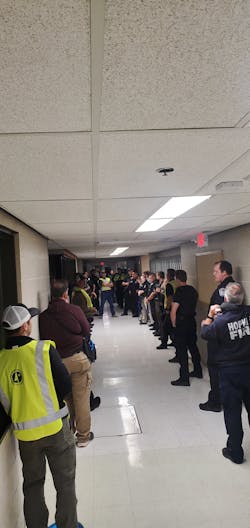MN Public Safety Agencies Partner for Active Shooter Training
For 10 years, public safety officials from throughout Hennepin County facilitate a mass killing regional response training. This brings together all four disciplines in fire, police, EMS, and dispatchers to provide a unified front to minimize casualties in active shooter events.
“If your active killer, rapid mass murder response is not evolving, you’re behind,” said Plymouth Police Sgt. Chris Kuklok, who also sits on the regional response board.
Shootings at Columbine, Sandy Hook, Virginia Tech and the Route 91 Harvest music festival resulted in a combined 131 deaths.
Last month's regional response training brought together 39 out of the 40 cities in the county to not have to look at numbers like 131 again.
“Every single time on a major incident, there is going to be an issue with communications," said Kuklok. "Every after-action report you look at, that is a problem. We're doing a disservice if we don't try to fix it."
The steps being taken to improve communication starts at the root of it all. The fact that all four disciplines are designing a system together and creating policies and procedures about how they communicate shows a level of uniqueness. Everyone always has a say in the matter of changes and growing the training.
Agencies in southwest Hennepin County had started their training on active shooters, and shortly after that the northwest region followed suit. In 2014, the two decided to combine forces and train together.
Training requires many hands
The desire ti improve starts at the top of the food chain. The Hennepin County Fire Chiefs Association and the Hennepin County Police Chiefs Association are represented by Plymouth Fire Department Battalion Chief Steve Baker and Hopkins Police Lt. Greg Pilon, who also serves on the board of regional response board.
From there, it is about each of the departments holding themselves accountable to send their staff to the training. Throughout the county there are several thousand firefighters, police officers, paramedics and dispatchers that need to be trained on the matter. It’s about being on the same page from the start, and that’s the biggest theme of the training.
Creating the training is a long process. The trainers must teach a different set of people each day. All agencies must band together, and cross the norm where firefighters are used to working in small groups and police are used to working by themselves.
Then you have the volunteer role players that need to be obtained. Without the volunteers acting as the civilians in the practical portions of the training, there is no training. They are crucial to the success and execution of the entirety of the process.
Another major challenge along with finding volunteers, locations and participation has to do with funding.
The options are between paying participants overtime, taking them off their shift which means less coverage, or even mandating attendance. That’s a struggle, however it’s getting combatted by the buy-in from around the county.
Four phases of training
Starting at 1 p.m., the classroom fills with approximately 40 firefighters, police officers, paramedics, and dispatchers and a baseline scenario is set involving a single shooter.
The Phase 1 briefing begins with all four disciplines receiving pre-arrival breakdowns and understanding consistent overall terminology. After that, it’s classroom then hands-on for the remaining three phases.
For Phase 2, which is hands-on, fire and EMS work together and police are separated with all focused on their respective duties. Police are entering and engaging the suspect, while fire and EMS are in another area reviewing equipment, medical treatment and practicing patient packaging and evacuation. The scenario has a hard stop when police engage the suspect.
Phase 3 kicks off right where police left off when engaging the suspect. Police will be focusing on securing the corridor and their communications with everyone involved. Fire and EMS simultaneously are running through as Triage Rescue Teams (TRTs) going into an area and treating and extracting victims.
Then, it's back to the classroom for Phase 4 where everyone is brought together. The dispatchers are now more involved as they sit in on the final phase of run-throughs.
“The key players involved dispatch, somebody who's in charge inside the incident and somebody who's outside taking command of the whole thing. Those three people are going to be the driving force behind your success,” said Kuklok.
A huge aspect of Phase 4 involves communication between fire/EMS and police as they begin to work off each other. It is centered around the full extraction and treatment of wounded people on scene. The focus isn’t on the physical treatment, as the wounded are marked with blue tape, rather the communication that goes into the treatment.
Afterwards, the phases are meshed in full blown run-throughs based on Phases 2, 3 and 4 with each agency communicating the entire time.
There are 10 scenarios for Phases 2-4 that work with incident command to establish a unified command early on between fire, police and EMS. The variables that are controlled by the trainers throughout the scenarios vary between the amount and location of either wounded, victim viability, and the location of the shooter.
“Typically, the most challenging is going to be a scenario that will test the communications process and the managing of resources," Baker said "Meaning, if the first TRT enters and has more wounded people than TRTs available at that time, they need to care for as many people as possible. This will test their medical skills and ability to communicate with each other during crisis.”
This was a process of looking inside themselves and questioning what was going on and taking feedback from all parties and implementing that information.
Evolving the training
St. Louis Park Dispatch Manager and instructor of the 9-1-1 portion of the training, Eric Lammle, took home a lesson from the Minneapolis-St. Paul Airport dispatch center when they attended the training on one of their concepts where they were being flooded with calls and determining who to keep on the line.
“What we do today isn't a finished product. It's incumbent on everybody that's here to take this back to their agency and decide to refresh on it,” said Lammle. “Because, if we were to perform this exercise three months later with the same people, we'd be rusty already.”
The recent expedient emphasis on regional responses was spiked when the Robb Elementary School in Ulvade, TX, happened.
According to St. Louis Park Police Sgt. Dennis Hagen, the program had “completely revamped” through the committee in the last year and a half. Hagen also talked about the importance of understanding what each other’s roles are to better serve the team. Everyone needs to know the entire playbook to understand what others are doing, so they can do their own job better.
“It’s a work in progress, and it will never not be a work in progress. As we do each class, we're finding a little something. We listen,” said Hagen. “When somebody goes, ‘Hey, wouldn't this be better?’ We come back, and we have that conversation because we don't want to get stuck in that this is how we've always done it.”
The training doesn’t go unnoticed. Hennepin County has had cities from across the country ask for their plans. Each public safety system is designed completely differently, but this begins some sort of unity. Hennepin County’s goal is to host five of these four-day long sessions in 2024.
“I think the biggest thing is just getting the buy in from all the agencies. That’s one thing (working with other agencies in other counties) that they are very impressed with, is getting all these chiefs together from across the county,” said Pilon. “All to agree on one thing, coming together and agreeing that this is what we need.”
The development of the program over the last decade has been exponential.
Baker has been involved in the leadership of this specific training for a decade and says he sees one of the two biggest issues as the lack of time. There isn’t enough time to quickly train thousands of people. Additionally, having people willing to make the leap into the unknown poses another challenge.
“Often, people need to create what they believe is the perfect plan before they are willing to step forward. I am very grateful for the team of visionaries that I have had the opportunity to work with in the past 10 years while conducting this training,” Baker said. “We put together a plan and we have improved the plan each year. Both operationally and in how we conduct training.”
He emphasized the fact that an uptick in frequency is necessary, not only because it’s an ever-changing issue but the complexity of the potential scenario is massive. With multiple cities responding, it can create murky waters.
“You don't have a choice but to be training together. The sheer fact that you have upwards of 16 different organizations involved is going to create a whole different problem,” said Baker. “You must be training together. You have to be working together on this.”
About the Author

Ryan Baker
Ryan Baker is a writer and associate editor with prior experiences in online and print production. Ryan is an associate editor for Firehouse with a master's degree in sciences of communication from the University of Wisconsin-Whitewater. He recently completed a year of teaching Intro to Public Speaking at UW-Whitewater, as part of his graduate program. Ryan acquired his bachelor's degree in journalism in 2023 from UW-Whitewater, and operates currently out of Minneapolis, MN. Baker, also writes freelances for the Ultimate Frisbee Association (UFA) in his free time, while also umpiring baseball for various ages across the Twin Cities Metro Area.

